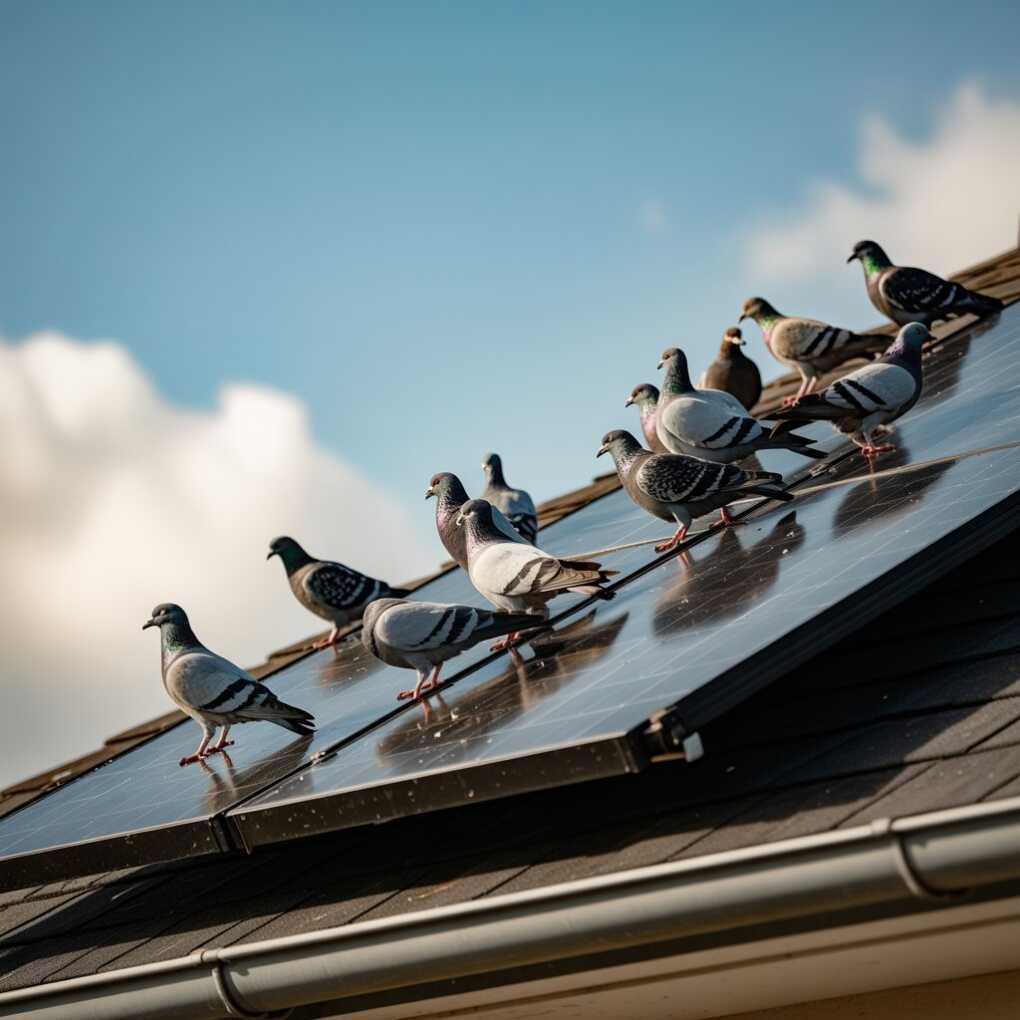When most people think about solar maintenance, they picture panel cleanings, energy monitoring apps, or perhaps an annual inspection. Few realize that one of the biggest threats to rooftop solar systems doesn’t come from weather or wear and tear—it comes from wildlife. Birds, squirrels, raccoons, and even seagulls don’t just live near solar panels. They often try to live under them.
In Southern California, where homes blend coastal breezes with lush neighborhoods, animals find rooftop solar an inviting space. Panels provide shade, warmth, and protection from predators, making them the perfect nesting spot. Unfortunately, what’s convenient for wildlife can be damaging, and even dangerous, for homeowners.

How Wildlife Damages Solar Panels
Wildlife interactions with solar panels go beyond occasional nuisance. The problems they create are both structural and electrical:
- Nesting Materials: Birds and squirrels often wedge twigs, leaves, and other debris under panels. This blocks airflow, traps moisture, and accelerates roof deterioration.
- Droppings: Pigeon or seagull droppings are acidic. Over time, they corrode panel surfaces, metal framing, and even roof shingles.
- Chewed Wiring: Squirrels and raccoons are notorious for chewing through electrical wires. Exposed wiring isn’t just costly to repair—it poses a fire hazard.
- Blocked Drainage: Debris buildup prevents water from flowing off rooftops properly, creating standing water that can lead to leaks.
In some cases, wildlife damage reduces system efficiency by 20–30%. In more severe cases, the damage requires costly electrical repairs and roof restoration.
Local Risks in Coastal Cities
For homeowners near the coast, seagulls add another layer of risk. Rooftops close to the beach become prime roosting spots. Their droppings not only reduce panel efficiency but also stain roofing materials, leaving long-term damage.
Santa Monica and other coastal cities face additional corrosion issues because salty air mixes with organic debris left by animals. This combination accelerates rust and decay, especially on metal racks and mounts. Without preventive measures, systems can degrade much faster than expected.
Why It’s More Than a Nuisance
Some homeowners dismiss animal activity as a minor inconvenience. However, wildlife damage to solar systems isn’t just cosmetic; it can compromise safety and security.
- Electrical Hazards: Chewed wires and short circuits create the risk of fire.
- Roof Integrity: Trapped moisture and blocked airflow speed up roof damage, leading to leaks that spread inside the home.
- System Efficiency: Even small nests or droppings can reduce sunlight exposure enough to impact energy consumption and, consequently, energy bills.
Solar is a decades-long investment. Without protection, homeowners may face recurring service calls, rising maintenance costs, and shortened system lifespan.
The Case for Prevention
Once animals discover a rooftop system, they tend to return to it. Cleaning nests or droppings solves the immediate problem, but it rarely prevents the issue from recurring. The most effective approach is proactive prevention.
Professional critter guard installation (insert blog link here) creates a physical barrier that blocks animals from entering the space beneath panels. These guards are typically made of mesh or metal strips and are installed around the perimeter of the array. They’re designed to allow ventilation while preventing birds, squirrels, and other critters from nesting.
The installation process usually takes only a day, yet it provides long-term protection. By sealing off vulnerable gaps, critter guards help preserve both the roof and the solar system.
Signs It’s Time to Act
Homeowners don’t always notice wildlife activity right away. Look for these signs that your system may already be under attack:
- Scratching or scurrying noises near the roof.
- Nesting debris is visible at the edges of panels.
- Unexplained performance dips in monitoring apps.
- Visible droppings or stains on panels or the roof.
- Water is pooling near the panel mounts after rain.
If any of these issues appear, scheduling an inspection is the first step. The sooner the damage is identified, the easier it is to address.
Protecting the Roof That Powers Your Home
Solar panels are designed to last 20 to 25 years, but their lifespan depends heavily on the environmental conditions surrounding them. In Los Angeles and coastal cities like Santa Monica, wildlife is a genuine and ongoing concern. Ignoring it can lead to higher repair bills, roof damage, and even safety risks.
By recognizing wildlife as more than a nuisance, homeowners can take simple steps to protect their systems. Prevention, particularly in the form of critter guard installation, provides peace of mind and helps ensure solar continues to deliver clean, reliable energy for decades.
Solar energy is one of the smartest investments a homeowner can make
Like any investment, it requires care. While most people focus on cleaning and performance monitoring, wildlife protection is an equally important part of solar maintenance.
Birds, squirrels, raccoons, and seagulls see rooftop panels as prime real estate. Without barriers, they can cause real damage—corroding surfaces, chewing wires, and undermining roof integrity. Homeowners who act proactively can avoid recurring headaches and protect their systems for the long run.
A simple guard installed today can prevent years of problems tomorrow. In a city that prides itself on sustainability, it’s a small but crucial step toward ensuring your solar panels work as hard—and as safely—as they should.
